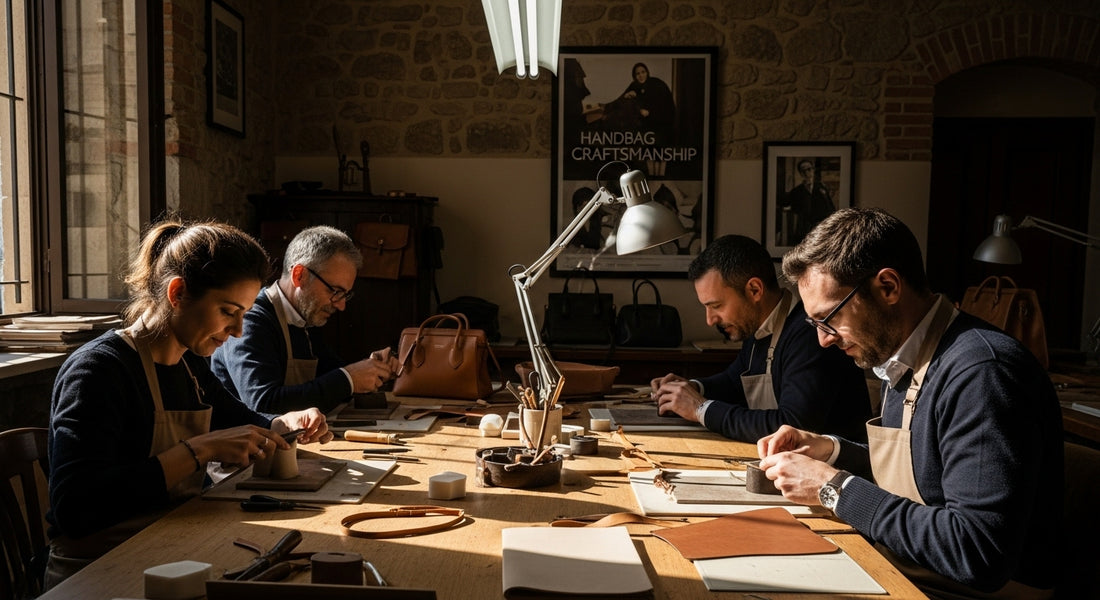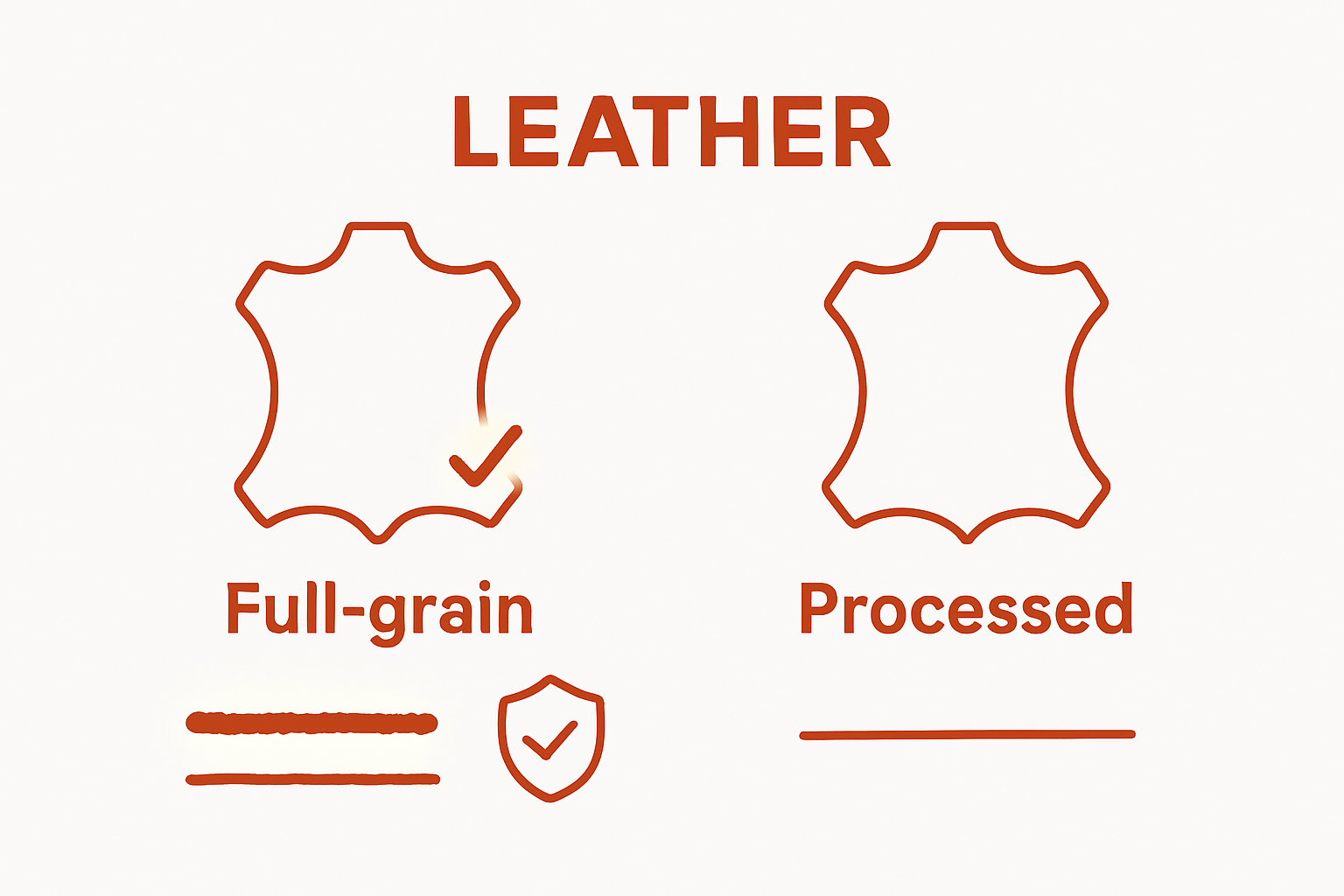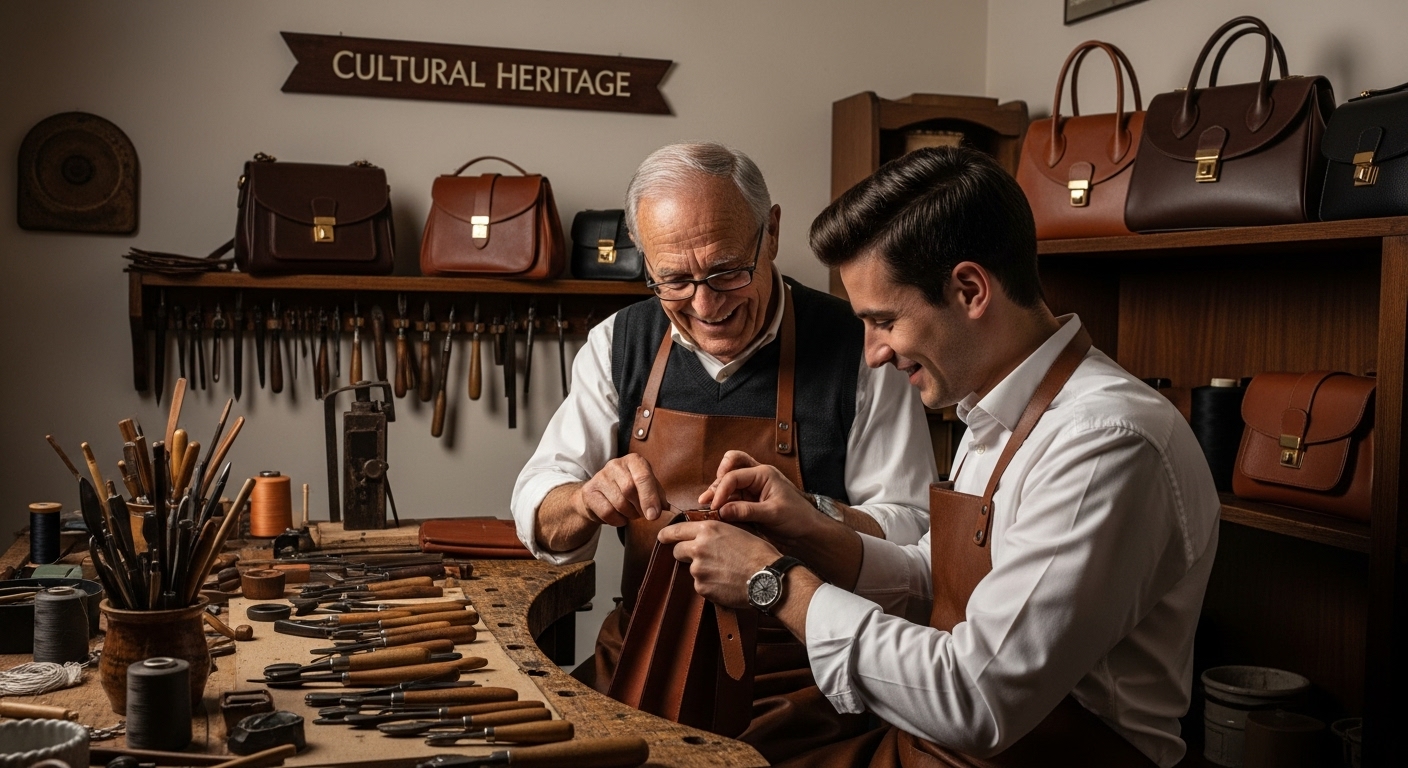
Understanding How Italian Handbags Are Made
Share
Italian handbags have long been icons of style, admired across the globe for their lasting elegance. Yet many do not realise that a single Italian handbag can take several days of meticulous handcrafting, with most of the work done by skilled artisans passed down through generations. While machine-made alternatives crowd the market, Italian craftsmanship remains stubbornly personal and painstaking, making each piece not just fashion but a living story ready to be discovered.
Table of Contents
- The Essence Of Italian Handbag Craftsmanship
- Materials That Define Quality And Luxury
- The Traditional Techniques Behind Italian Handbags
- Ethical And Sustainable Practices In Handbag Production
- Cultural Heritage And Its Impact On Design
Quick Summary
| Takeaway | Explanation |
|---|---|
| Traditional craftsmanship preserves cultural heritage. | Italian artisans utilise generational knowledge to maintain rich cultural practices in handbag creation. |
| Full-grain leather ensures premium quality. | This material’s natural properties provide durability, breathability, and unique character over time. |
| Artisans prioritise quality over quantity. | Each handbag is meticulously handcrafted, often taking multiple days for exceptional craftsmanship. |
| Sustainable practices minimise environmental impact. | Italian manufacturers are adopting eco-friendly methods, including responsible material sourcing and waste reduction. |
| Cultural narratives influence design choices. | Handbags embody traditional motifs and techniques that reflect Italy’s cultural identity and artistry. |
The Essence of Italian Handbag Craftsmanship
Italian handbag craftsmanship represents a sophisticated fusion of artistic tradition, technical precision, and generational expertise. At its core, this craft transcends mere manufacturing, embodying a philosophy where each handbag is a narrative of cultural heritage and meticulous skill.
The Legacy of Traditional Techniques
Traditional Italian leather craftsmanship is deeply rooted in centuries of familial knowledge passed through generations of artisans. These craftspeople do not simply create products they preserve a rich cultural legacy. According to research exploring craftsmanship in the Italian fashion market, Italian manufacturers have maintained global competitiveness by preserving intricate production processes executed by master craftsmen.
Key characteristics of Italian handbag craftsmanship include:
- Commitment to using premium full-grain leather
- Handcrafted detailing with minimal machine intervention
- Precision in cutting, stitching, and finishing techniques
The Philosophy of Quality Over Quantity
Unlike mass production models, Italian handbag makers prioritize quality and individual artistry. Each handbag represents a carefully curated process where artisans invest significant time and expertise.
Learn more about our approach to traditional leather craftsmanship and discover how we maintain these time-honoured techniques.
This dedication means that a single handbag might require multiple days of intricate work, with each stage carefully executed to ensure exceptional durability, aesthetic beauty, and functional excellence. The result is not just an accessory but a testament to human skill and artistic expression.
Materials That Define Quality and Luxury
In the world of Italian handbag manufacturing, materials represent far more than mere components they are the foundational elements that define luxury, durability, and aesthetic excellence. The selection and treatment of materials reflect a profound commitment to quality that distinguishes Italian craftsmanship.
Full-Grain Leather: The Premium Standard
Full-grain leather stands as the pinnacle of material selection in luxury handbag production. Unlike processed leathers, full-grain leather retains the entire natural hide surface, including all original markings and imperfections. According to research exploring material sustainability in Italian fashion, understanding material origins and production processes is crucial for maintaining environmental and ethical standards.
Key characteristics of premium full-grain leather include:
The following table summarises the key characteristics of premium full-grain leather used in Italian handbags, making it clear why this material is highly valued by artisans.
| Characteristic | Description |
|---|---|
| Natural breathability | Allows air to circulate, preventing moisture build-up and preserving leather quality. |
| Superior durability | Withstands wear and tear, retaining structural integrity over extended use. |
| Unique patina development | Acquires individual character and sheen with age and handling. |
| Minimal processing | Maintains original grain and natural imperfections for authenticity and strength. |
| Resistance to wear and tear | Exhibits toughness, making it ideal for everyday luxury handbags. |

- Natural breathability and superior durability
- Ability to develop a unique patina over time
- Minimal processing that preserves the leather’s original strength
- Resistance to wear and tear
Beyond Material: Ethical and Sustainable Sourcing
Italian handbag makers increasingly recognise that luxury is not just about appearance but also about responsible production. Explore our commitment to traditional leather craftsmanship and how we select materials that meet rigorous quality and ethical standards.
Materials are carefully chosen not only for their aesthetic qualities but also for their environmental impact and ethical production. This holistic approach ensures that each handbag represents not just a fashion accessory, but a statement of conscious consumption and respect for traditional manufacturing techniques.
The Traditional Techniques Behind Italian Handbags
Traditional Italian handbag production represents an intricate dance of skill, precision, and cultural heritage. Each technique has been meticulously developed and refined over generations, transforming leather crafting from a mere manufacturing process into an art form that celebrates human creativity and technical mastery.
Artisanal Cutting and Leather Preparation
The initial stages of handbag creation demand extraordinary precision. Master artisans carefully select and inspect each leather hide, looking for optimal sections that showcase natural grain patterns and structural integrity. According to computational research exploring textile techniques, these selections are not random but deeply intentional, involving sophisticated understanding of material properties.
Key principles of traditional leather cutting include:
- Minimising material waste through strategic hide placement
- Preserving natural leather characteristics and imperfections
- Ensuring symmetry and structural consistency
- Maintaining leather’s inherent strength and flexibility
Hand Stitching: A Generational Skill
Hand stitching represents the pinnacle of Italian leather craftsmanship. Unlike machine production, these techniques involve using specialized needles, waxed threads, and techniques passed down through family workshops. Learn more about the future of Italian leather craftsmanship and how traditional methods continue to evolve.
Each stitch is carefully placed, with artisans ensuring perfect tension, alignment, and durability.
This table outlines the traditional steps involved in Italian handbag production, providing a clear overview of each technique featured throughout the crafting process.
| Production Stage | Purpose | Key Focus Area |
|---|---|---|
| Leather Selection and Inspection | Ensures use of the highest quality hides | Grain pattern, integrity |
| Precise Cutting | Shapes individual pieces while minimising waste | Strategic placement, symmetry |
| Hand Stitching | Assembles components with strength and artistry | Alignment, stitch tension, durability |
| Edge Finishing and Polishing | Enhances durability and aesthetic appeal | Smoothness, evenness |
| Final Quality Inspection | Guarantees the finished product meets artisan standards | Functionality, appearance, feel |
| This meticulous approach transforms a simple functional requirement into an aesthetic statement, where every puncture and thread represents centuries of accumulated knowledge and skill. |
Ethical and Sustainable Practices in Handbag Production
Sustainability in Italian handbag production transcends environmental considerations, representing a holistic approach that integrates ecological responsibility, social equity, and artisanal preservation. This comprehensive perspective transforms manufacturing from a mere industrial process into a conscientious dialogue between craftsmanship, human dignity, and environmental stewardship.
Reducing Environmental Impact
Italian manufacturers are pioneering innovative strategies to minimise ecological footprints. According to research exploring sustainable fashion paradigms, the leather goods industry is increasingly focused on developing production methods that significantly reduce waste and pollution.
Key sustainable practices include:
- Utilising vegetable-tanned leathers with minimal chemical processing
- Implementing water recycling systems in manufacturing facilities
- Selecting leather from responsibly managed agricultural sources
- Minimising material waste through precision cutting techniques
Ethical Labour and Social Responsibility
Beyond environmental concerns, sustainable production encompasses profound human rights commitments. Learn more about our approach to slow fashion and how we prioritise worker welfare throughout our production process.
Ethical practices involve ensuring fair wages, safe working conditions, and genuine respect for artisan expertise. By valuing human skills and providing dignified working environments, Italian handbag manufacturers demonstrate that true luxury is not just about aesthetic excellence, but about creating value for every individual involved in the production journey.
Cultural Heritage and Its Impact on Design
Cultural heritage represents more than historical artifacts it is a living, breathing narrative that continuously shapes contemporary design. For Italian handbag makers, this heritage is not a static concept but a dynamic dialogue between tradition and innovation, where each stitch and seam tells a story of generational craftsmanship and artistic evolution.
Narrative Through Design
Italian design inherently communicates cultural stories, transforming functional objects into repositories of collective memory. According to research exploring design and cultural heritage, design becomes a powerful medium for preserving and reinterpreting cultural narratives.
Key elements of cultural heritage in design include:
- Incorporating traditional motifs and patterns
- Respecting historical crafting techniques
- Reflecting regional aesthetic sensibilities
- Maintaining authenticity while embracing contemporary interpretations
Generational Knowledge Transfer
The transmission of design knowledge represents a critical aspect of cultural preservation. Artisan workshops serve as living universities where skills, techniques, and aesthetic sensibilities are passed from master craftsmen to emerging designers. Learn more about our commitment to traditional leather craftsmanship and how we honour these generational connections.
Through this continuous exchange, Italian handbag design transcends mere manufacturing it becomes a profound expression of cultural identity, where each creation carries the whispers of past generations and the aspirations of future artisans.

Experience True Italian Artistry in Every Bag
Have you ever wished your handbag could tell a story of real tradition rather than just follow a fleeting trend? The journey behind genuine Italian handbags is one filled with dedication to age-old craftsmanship, careful full-grain leather selection, and an unwavering respect for cultural heritage. The problem many shoppers face is finding accessories that are not only beautiful but also authentically crafted and ethically produced. At San Rocco Italia, these goals become a reality. Our boutique champions the very techniques and values detailed in the article, offering handbags handmade in Italy by artisans who have perfected their skill over generations. Each piece captures the essence of meticulous cutting, hand-stitching, and premium materials, ensuring your purchase is more than an accessory. It is an heirloom of artistry.

Why settle for ordinary when you can hold true Italian tradition in your hands? Discover our selection of luxury handbags and leather goods and learn more about our commitment to traditional leather craftsmanship. Experience the difference today at San Rocco Italia. Shop now and bring Italian excellence home before these one-of-a-kind pieces find their owners.
Frequently Asked Questions
What materials are typically used in Italian handbag production?
Italian handbags are primarily made from premium full-grain leather, which retains the natural surface of the hide. This type of leather provides exceptional durability, breathability, and the ability to develop a unique patina over time, enhancing the bag’s aesthetic appeal.
How do Italian artisans ensure the quality of each handbag?
Artisans meticulously inspect leather hides for optimal sections before cutting. They employ traditional techniques such as artisanal cutting, hand stitching, and careful attention to detail at every stage, ensuring each handbag is crafted with precision and quality in mind.
What are the sustainable practices involved in the production of Italian handbags?
Sustainable practices include the use of vegetable-tanned leathers with minimal chemical processing, water recycling systems in manufacturing, and sourcing materials from responsibly managed agricultural sources. These practices help minimise environmental impact while ensuring high-quality craftsmanship.
How does cultural heritage influence the design of Italian handbags?
Cultural heritage influences Italian handbag design by incorporating traditional motifs and patterns, respecting historical techniques, and maintaining authenticity. This approach allows for a continuous dialogue between past craftsmanship and contemporary design aesthetics.


